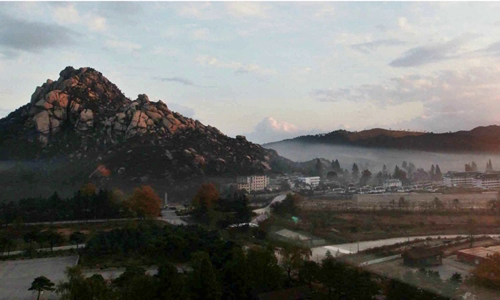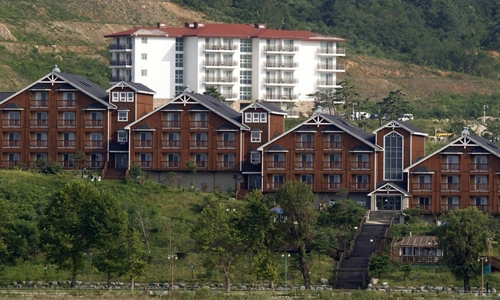South Korea is calling on the United States to approve them to resume cross-border tours to Mount Kumgang in North Korea.
According to Seoul, this is not a compromise for international sanctions imposed on Pyongyang, but also contributes to improving bilateral relations.

A corner of the mountain resort of Kumgang Photo: Reuters
The Kumgang Mountain Resort is one of two projects that symbolize the unification of the two Koreas, the other being the Kaesong joint industrial park that no longer exists. However, North Korean leader Kim Jong-un recently threatened to demolish Korean-funded structures on Mount Kumgang.
South Korean Unification Minister Kim Yeon-chul in early November went to Washington to urge the US to allow them to resume tours, while more than 50% of South Korean parliament members passed a resolution approving the proposal. This campaign and a public campaign to collect 10 million signatures in support are being launched.
At a press conference with foreign correspondents on November 19, Choi Moon-soon, the governor of Gangwon Province, located near Mount Kumgang, said the resumption of tours would ensure "an important breakthrough in The diplomatic effort is stalled between North Korea and the US and at the same time breaking the deadlock in inter-Korean relations. "
Revitalizing tours "will help North Korea move forward on the path of reform and opening up", the goal that Kim Jong-un's leader is aiming to, Choi emphasized. Gangwon Province is located on the border between Korea and South Korea.
Kim Jong-un said last week that the buildings in the Kumgang Mountain Resort looked like works on a "construction site" and Pyongyang should renovate them "in a Korean modern way".
Mount Kumgang, located on the east coast of the Korean peninsula, is not subject to sanctions from the UN Security Council over Pyongyang's nuclear weapons program, but Washington has expressed concern that North Korea could Using foreign currency collected from the resort to develop the arsenal.
The Kumgang Mountain Resort opened in 1998 as a symbol of Korean-Korean cooperation, but Seoul canceled its tours in 2008 after a Korean tourist was shot dead by Korean soldiers after entering the area. prohibited area.
Choi said that as many as 1.2 million Chinese tourists went to North Korea last year, many of whom visited the Kumgang mountain resort. But the Unification Ministry said the figures could be exaggerated because according to South Korean statistics, the number of Chinese tourists to North Korea is only about 200,000.
Participants at the press conference on November 19 also included officials and business leaders. They noted the significant economic impact of not being able to resume the tour to Kumgang and insisted that Pyongyang would not benefit from the dollar earned from tourism.
Lee Kyung-il, mayor of Goseong district, where the Kumgang mountain tour started, said 400 shops had to be closed and 27,000 residents had suffered a total of $ 330 million in damage over the past 10 years Tour stopped.

Korean-built hotels in the Kumgang Mountain Resort Photo: AP
"When the door is closed and the clock is spinning, we have to seize the last chance to resume the Kumgang mountain tour," he said.
On the other hand, according to the Korea Institute of Tourism and Culture, the country's companies also lost up to US $ 1.34 billion for the construction of the works, besides applying for a license to operate at Mount Kumgang.
Shin Yang-soo, who is in charge of helping Korean businesses approach the investment channel in Kumgang, denied that Seoul wanted to "transfer money" to North Korea through tours. "Only one-tenth of the money the Koreans spend on tours flows into the pockets of the Koreans. It's not a huge amount of money that can make a big difference," he said.
Before the tour was halted, 1.95 million South Koreans visited Mount Kumgang. They pay between $ 30 and $ 80 per person as an entry fee for North Korea and spend money to buy souvenirs.
"Nothing else has fallen into the hands of North Korea," Shin said.
Koreans only use the hotel and other facilities at the resort, built by Hyundai Asan, at a cost of 780 billion won (US $ 668 million). Hyundai Asan has a 50-year contract to develop a tour to Mount Kumgang after paying North Korea $ 500 million.
All travel expenses and expenses spent on resort facilities are transferred to Hyundai Asan and other Korean suppliers, Shin said.
According to Professor Yang Moo-jin from Korea Research University in Seoul, regardless of how much Korean money earned from tours is large, the revival of them is a symbol of Korean cooperation and exchange - Tide.
"However, I am skeptical about whether the US will accept the request from Seoul or not because Washington always maintains the view that no loose expression exists when implementing sanctions on North Korea," he said. evaluate.



 TinaHutchins
TinaHutchins







